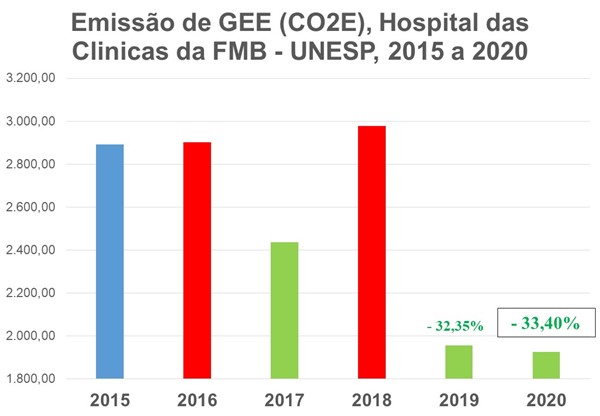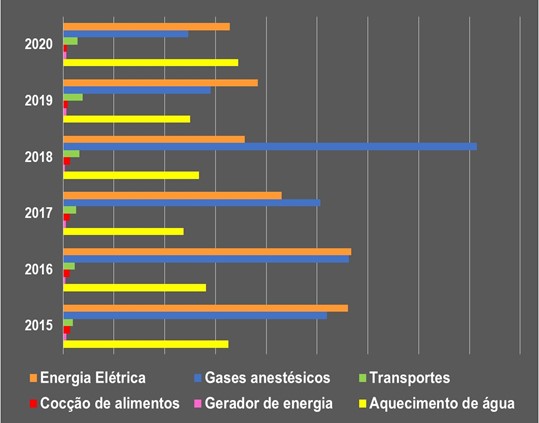Reducing GHG emissions & strengthening leadership and resilience
Clinical Hospital of Botucatu Medical School (HCFMB), Brazil
Case study summary
This case study reports on the challenges and path that a large public hospital in Brazil faced to reduce GHG emissions by 33.40% in five years. Goals included measuring emissions with GHG protocol tools creating indicators, and assessing risks, as well as strengthening climate leadership, resilience, and mitigation with training and education for professionals and students.
Demographic information
- City: Botucatu
- State/province/region: Sao Paulo
- Country: Brazil
- Type of institution: State public hospital of great size, high and medium complexity
- Number of full-time staff: 1,916
- Number of part-time staff: 1,123
- Number of beds: 650
- Patient population served annually
- 472,000 patients served annually (243,000 ambulatory consultations, 15,000 surgeries in 2022)
- Geographic area served by your institution: located in the center-west of Sao Paulo state, Brazil, population coverage area of around 2 million people, serving more than 70 cities
- Equity concerns experienced by your population- cardiovascular disease, pulmonary sepsis, cerebrovascular disease; social inequality – more vulnerable people have more difficulty accessing health care; socio-environmental injustice.
The issue
According to the 2022 Lancet Countdown report, only 48 of 95 countries have assessed the need for health services to be more adapted to the climate crisis, stating that "at the current critical juncture, an immediate and focused health response can still ensure a future in which the world's populations can not only survive, but thrive.” Health care services aggravate this picture by emitting many GHGs. The HCFMB, a large teaching hospital with a large carbon footprint, should play a leading role in climate mitigation and resilience by adopting more sustainable actions.
Hospital goal
Goals included decreasing GHG emissions by 30%, improving data collection for GHG protocol (since 2015), training professionals for climate leadership, and building resilience and future adaptations. Additional actions involved creating indicators and risk assessments towards environmental, social, and financial sustainability.
Sustainability strategy implemented
We first joined the 2020 Health Care Climate Challenge in 2015 and soon realized the need to focus our strategy on climate change, including raising staff awareness and training professionals to face the impacts of climate change. Being a teaching hospital, we receive more than 1,000 undergraduate, specialization, and postgraduate students each year from all over the country, making it our duty to inform these professionals about ways to mitigate impact and adapt to climate change. Our aim was to show local examples of climate actions in our hospital.
HCFMB's GHG emissions (CO2) evolution from 2015 to 2020

HCFMB's GHG emissions (CO2) by source
Orange = Electric energy
Blue = Anesthetic gases
Green = Transportation
Red = Cooking food
Pink = Energy generator
Yellow = Water heating

Implementation process
Since 2013, we have joined the Healthy Hospitals Project and Health Care Without Harm. In 2015 we committed to the climate challenge, measuring our GHG emissions, creating indicators, and assessing the most critical points with the greatest emissions that we could reduce. We have also been improving data collection in each area by raising the awareness of the professionals involved. In 2018, we noticed a 22% increase in overall emissions related to scope 1 (43.6%) by consuming more than 56% nitrous oxide. The NHS and anesthesiology discovered leaks in all 13 operating rooms in an old, poorly maintained hospital. We set up a GHG committee involving the maintenance service, anesthesiology department, nursing staff, engineering, and architecture. Maintenance reviewed all valves of all gases used in the hospital. In 2019 we reduced our emissions again, and in 2020 we managed to reduce our GHG by 33.40% since 2015.
We have included discussions on climate change and sustainable hospitals in undergraduate courses in medicine and nursing, various specializations, medical residency, and postgraduate courses at the School of Medicine of Botucatu at São Paulo State University.
Tracking progress
In 2018 we noticed a 22% increase in overall emissions related to scope 1 (43.6%) by consumption over 56% nitrous oxide. NHS and anesthesiology discovered leaks in all 13 operating rooms in an old, unmaintained hospital. A GHG commission was established to outline an action plan. We investigated the surgical center first and then additional areas where other gases (nitric oxide, oxygen, nitrogen, compressed air, argon, natural gas, carbon dioxide, and inhalation anesthetics) were used. After addressing leaks, we had a 64.3% drop in nitrous oxide in 2019 and maintained it in 2020 (53%), with savings of USD 14,000 with this gas and around USD 145,000 with the others, identifying oxygen leaks months before the COVID-19 pandemic began.

The success of our project is due to the work of a multi-professional Greenhouse Gas Commission of HCFMB. This work to reduce emissions by 33% from 2015 to 2020 managed to register the environmental impact, but also the economic impact of controlling our emissions. By identifying and addressing a nitrous oxide leak, we were able to address an occupational health issue.
Challenges and lessons learned
Data collection and completion of the GHG protocol were challenging due to data availability and understanding. However, with support from PHS and awareness-raising efforts, we obtained higher-quality and more agile data. The GHG multiprofessional commission and teamwork were crucial for achieving our goal. Managers must be aware of the importance of GHG monitoring, mitigating hospital impact on climate change, and incorporating ESG principles in their actions. Such discussions must be included in professional training.
We were able to visualize the importance of the GHG protocol tool, which indicated to us where the cause of the increase in our emissions was and which processes and routines always need to be reviewed and improved.
The big challenge for the HCFMB team was the lack of financial resources and human resources, but we were able to identify and solve the nitrous oxide leak problem with the dedication of the various sectors involved and the resources available
With the result and knowledge of this work, the gas commission gained strength, to act in the control of all gases used in the hospital. The Sustainable Hospitals Core received more recognition by participating in many projects.
Next steps
We secured $2 million in funding for a major energy efficiency project from the National Electricity Agency including air conditioning, cooling, lighting, and clean energy generation through the installation of a 1,188 kWp photovoltaic plant, with an estimated annual reduction of 966 tCO₂. We continue measuring and evaluating our emissions through the GHG protocol in order to assess risks and points that we still need to improve.
Links
- Vídeo Institucional HCFMB - 2019 (Instructional video, English subtitles)
- Projeto Iluminação Livre de Mercúrio na Saúde (Mercury-Free Lighting in Healthcare Project, English subtitles)